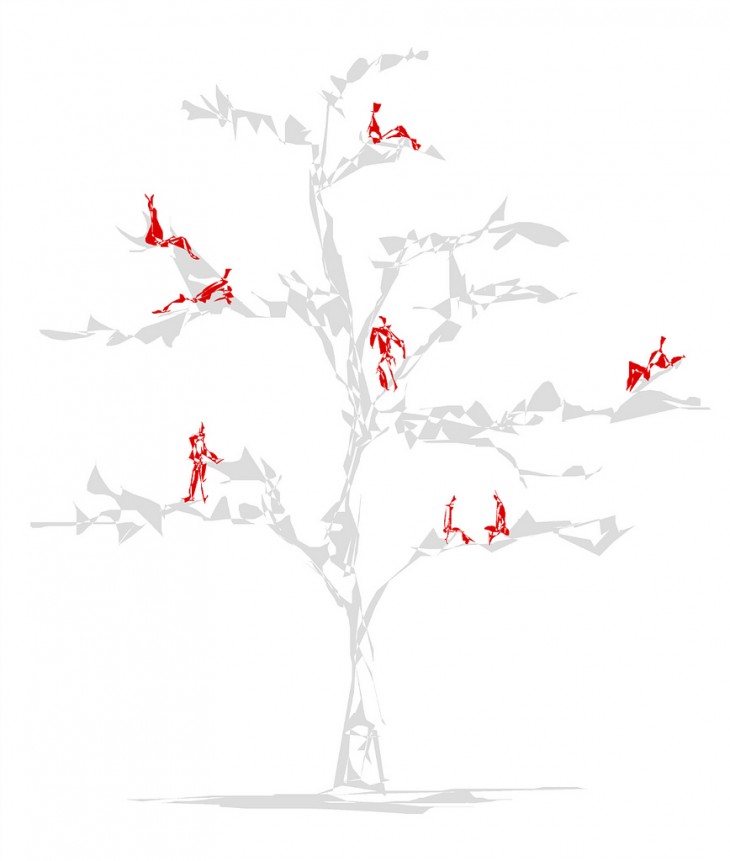>This manifesto addresses the future role of the architect in designing a primitive kind of space. It particularly refers to caves and ruins as references for the design of an architecture of diversity, complexity and emergence.
The Cave
The cave is a recurring theme carried out extensively throughout the paper. Why cave? Because it exists. Simply. It is discovered, explored and appropriated. It is nature. A natural ruin. Incomplete, Accidental; and thus much more pleasurable to adapt. The manner in which the cave is appropriated becomes purely a question of ergonomics. The human scale shall never be ignored. It is but celebrated.
Architecture of the future should embrace the qualities of the cave. Question is: how to purposely design a space of no predetermined purpose? Designing for an orchestrated disorder – A doubt arises.
As a designer, when do I stop the design process?
The Simple Diagram> The Possibility of Recognition - Impossibility of Comprehension
If we think of architecture as a simple diagram, we begin to set a framework for complex relationships to emerge. A clear diagram does not mean the architecture is simple; it just provides a clear framework within which complexity and irregularity can operate. Sou calls to abandon the top-down approach for a bottom up design strategy -A call for a catalytic architecture presented in its incomplete state. To Design for relationships: An open ended resolution of design that allows life to take unpredictable form.
1 nothing + 1 nothing = Something
Harmony arises from the emergence of relationships between components. Remove the orderly structure and there will be no chaos. Only harmony – an orchestrated chaos. When relationships emerge, the rigid structure is dropped.
Blurred Boundaries> Architecture as the Design of Interface
The notion of blurred boundaries covers both physical and relational realms: <Keywords: forest, cloud> Architecture in this article is defined as the making of the exterior envelope in form of an interface and not merely a façade. The designer should question and attempt to reinterpret, redefine and reinvent the relationship with the exterior. Gradation is one strategy we can find recurring in Fujimoto’s works. One way in which it is achieved is by Nesting or Layering: box within a box. The transition from inside to outside or vice versa is regularly interrupted to induce a sense of fuzziness, uncertainty, until the boundary is confused.
When the boundary is confused, it is lost.
Reversibility- when boundaries are confused, the relative position could be reversed. Inside could become outside and the opposite. The house could become the city and vice versa. Blurring the boundaries is pushed further to reversing the scales. An architect can now design the house as a city and start planning the city as if it was a house leaving no detail untreated.
>the relationship between the designer and the user gets blurred in such a situation as they both potentially surprise one another – They both don’t know what to expect as they confront the same unknown.
Relational Themes
Ultimately, Foujimoto’s architecture is a testimony to architecture’s disturbed relations with its context. Through manipulating the interface in unconventional ways, he questions taken-for-granted values of public v/s private; in v/s out, natural v/s man-made, creating a general atmosphere of unease. The design decisions he takes directly affect the users’ life and are never neutral with respect to the entourage
On the other hand, he repeatedly references nature’s layering, changeability, unpredictability and diversity (forest, clouds, caves, mutations…). Designing in parallel to natural forms of existence gives Foujimoto’s work metaphorical relations with the natural environment. Just like nature intrigues and inspires us in many ways, Sou opts for an enticing adventure in man-made ‘accidents’.
Relationship to the other Texts
Foujimoto understands function as an outcome. He revolts against the imposed structure suggested by Modern architecture, and thereby calls for Deprogramming, similar to the other texts. Function is not to be designated. We should design for relationships to emerge. By creating a framework for different things to happen, we are designing for flexibility, adaptability, diversity and liveliness. This flexibility gives architecture a 4rth dimension where time becomes a key element in displaying the full palette of gradation available within a particular context.
Research Interest
Bottom up approaches today gain popularity and much recognition with the rise of parametric and computational digital design tools. The architect’s role and scope of work in shaping the built environment is reformulated as we confront a major paradigm shift.
Now that we understand that the main area of interest lies within the process rather than final outcome, the challenge becomes how to design for an empowered community enjoying enough freedom to transform spaces into places –how to provide the framework for things to happen, to irrigate territories with potential by providing catalytic interventions and consequently, stage and celebrate the uncertain.
If architecture should be regarded as an animated, living domain, in a continuous state of evolution, what parameters should guide the design process and inform the designer’s strategic approach? What will the architect be designing and what limitations does he have to face? How does the architect-user relationship inform the design process and how will the architect of tomorrow know when to stop designing and when exactly to withdraw?


